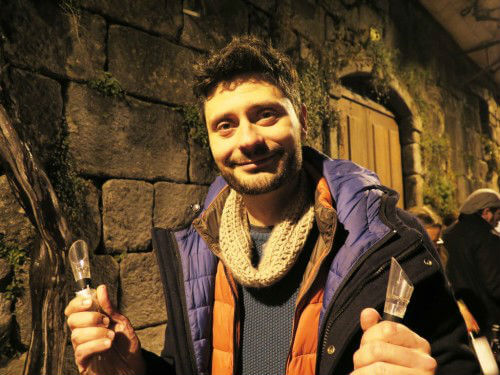Text Sarah Ahmed
In my last post about the Douro I urged you to “seek and ye shall find,” for no other Portuguese region can surely boast such a rich diversity of terroir? In fact, look hard enough and you can even unearth sweet wines in the Douro. I’m not talking Port, of course, but late harvest and botrytis influenced dessert wines, as in no (brandy) spirit required.
The addition of brandy spirit stops the fermentation process that transforms grape sugars into alcohol, which explains why fortified wines like Port and Moscatel do Douro are sweet. Unfortified sweet wines, on the other hand, simply rely on having super-high sugar levels. Leave the grapes on the vine for long enough and, being dry and sunny, the Douro will lavish you with sugar. So why don’t we see more unfortified Douro sweeties?
The answer lies in the fact that a great dessert winemaker must be the consummate tightrope walker of sugar and acid balance.

Tightrope Walker in unbornmind.com
As grape sugars rise, grape acidity decreases. If the acidity is too low, the resulting wine will taste too sweet or, worse, flabby. Great dessert wines need both high sugar and high acidity. Not an easy combination in a hot, dry climate.
It’s why the handful of Douro sweeties I’ve encountered hail from elevated vineyards. And they can be mighty impressive. Take Rozès Noble Late Harvest 2009, which my panel awarded a Gold Medal and Sweet Wine Trophy at Decanter World Wine Awards 2011 or Quinta do Portal Late Harvest 2007, one of my 50 Great Portuguese Wines 2010.The more elevated the vineyard, the more elevated the acidity because, at altitude, temperatures drop markedly, especially at night-time. Add morning fog and humidity into the mix and you have the perfect conditions for botrytis to take hold. Rather improbably, this mold produces the most magical sweet wines not only because it concentrates both sweetness and acidity, but also because it produces a honeyed, often floral (camomile or saffron), complexity. No wonder it’s also called noble rot!

Tiago Sampaio of Olho no Pé at Simplesmente Vinho – Photo by Sarah Ahmed | All Rights Reserved
My latest dessert wine finds are made by Tiago Sampaio of Olho no Pé. Describing himself as “a one man show,” Sampaio’s curiosity about wine was triggered by his grandfather who first introduced a young Sampaio to the Douro’s vineyards and world of wine. But I suspect that the young winemaker’s dessert wine friendly focus on freshness results from his five years in Oregon (where he obtained a PhD in Viticulture and Enology). It certainly accounts for the pale but promising Pinot Noirs in his portfolio – the delicate Burgundian variety benefits from Oregon’s crisp, cool nights. Sampaio founded Olho no Pé after he returned to the Douro from the United States in 2007. The dessert wines which he showed me at Simplesmente Vinho earlier this year are both made from old field blend vines (70 years old plus) with a high proportion of Gouveio located in Alijó at 600 metres above sea level. Because of its elevation, like Favaios, the municipality is traditionally famous for its fresh, delicate Moscatel do Douro and, increasingly, for dry white wines. Here are my notes on Sampaio’s delicious sweeties:
Olho no Pé Colheita Tardia/Late Harvest
2011 (Douro)

Olho no Pé Colheita Tardia 2011 – Photo by Sarah Ahmed | All Rights Reserved
Sampaio has a very delicate touch. Handpicked grapes are picked in successive, highly selective harvests and, chock full of sugar (this wine has around 200g/l of residual sugar), it was naturally fermented very slowly. As it slowly transformed from grape juice to wine, complex aromas and flavours were unlocked – saffron spice, crystallised ginger, camomile and poached pears. Silky of texture, very fresh and pure, the wine was aged on fine lees in mature oak barrels which really let the fruit speak. Super-pretty with a beguiling, un-worked quality. 11%
Olho no Pé 2011 (Vinho, Portugal)
If I exaggerate, it’s only a little (for the Douro at any rate), but I reckon this yet-to-be- named cuvee boldly goes where none have gone before. It is the product of the most concentrated, botrytised grapes of 2011 (and, for that matter, all the vintages Sampaio has ever worked). Just two barrels were made which, with double the amount of residual sugar (400g/l) took much, much longer to ferment – two years! At 7% abv it is below the minimum level of alcohol for DOC Douro or VR Duriense classification, yet has the same tell tale saffron signature of botrytis as the Late Harvest wine – lovely lift and purity too. A satiny palate reveals delicate barley sugar, spun sugar and brighter, tighter, more focused fresh apple close to the core, giving it a welcome trace of balancing bitterness and bite. Toothsome yet fresh, concentrated yet with a levity, this sweet essence of grapes lingers long in the mouth and memory. An experience!
Contacts
Tiago Sampaio
Rua António Cândido, 7
5070-029 Alijó, Portugal
Mobile: (+351) 960 487 850
E-mail: info@foliasdebaco.com
Website: www.foliasdebaco.com




Leave a Reply